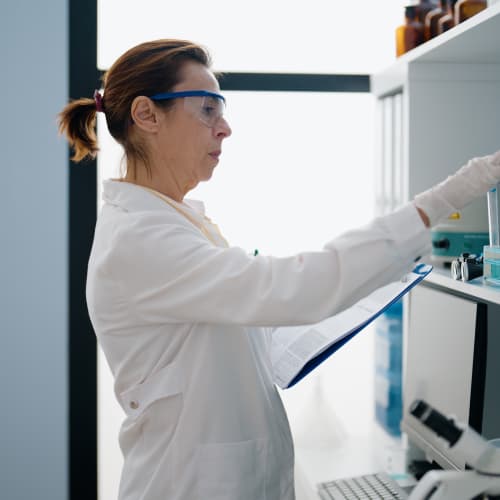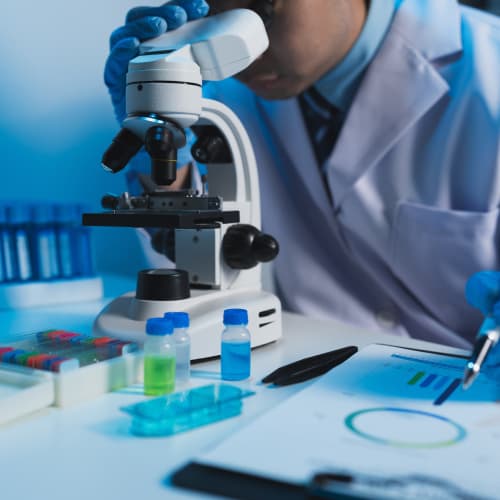USP <1469> outlines requirements and guidelines in testing for the presence of nitrosamines in pharmaceutical products. Nitrosamine impurities have been identified as potential human carcinogens, which can increase the risk of cancer and other illnesses, and thus must be carefully tested for and controlled. The conditions for nitrosamine formation are present in many pharmaceutical manufacturing processes, leading the FDA and CHMP to introduce guidelines to assess risk, control the levels of nitrosamine impurities, and provide transparency into the presence of potentially harmful molecules.
USP <1469> Nitrosamine Impurities Testing

The History of USP <1469>
In 2018, the presence of nitrosamines in valsartan led to a voluntary recall, an event that led to the first major introduction of guidelines around nitrosamine impurities. USP General Chapter <1469> nitrosamine impurities guidelines list maximum acceptable levels of a number of nitrosamines, as well as testing methods, processes, and scenarios.

Nitrosamines Covered Under USP <1469>
USP <1469> lists maximum acceptable levels and testing processes for the following nitrosamine compounds:
- N-nitroso-dimethylamine (NDMA) (maximum of 96 ng/day)
- N-nitroso-diethylamine (NDEA) (maximum of 26.5 ng/day)
- N-nitroso-N-methyl-4-aminobutyric acid (NMBA) (maximum of 96 ng/day)
- N-nitroso-methylphenylamine (NMPA) (maximum of 26.5 ng/day)
- N-nitrosoisopropylethyl amine (NIPEA) (maximum of 26.5 ng/day)
- N-nitroso-diisopropylamine (NDIPA) (maximum of 26.5 ng/day)
- N-nitroso-N-methyl-4-aminobutanoic acid (NMBA) (no limit listed)
As noted here, most nitrosamines have a maximum acceptable level of 26.5 ng/day, with two compounds — NDMA and NMBA — having an acceptable level of 96 ng/day. Each of these levels are considered comparatively low, meaning that testing equipment must be highly sensitive and carefully calibrated. In addition, nitrosamines can be difficult to detect. BA Sciences maintains the necessary equipment to reliably carry out these tests.
Nitrosamine Testing Methods
Nitrosamine testing is typically conducted via gas chromatography mass spectrometry (GC-MS) using a triple quadrupole mass detector. There is a known exception for the detection of NDMA in ranitidine. In this testing scenario, the high temperatures introduced by the GC-MS process may lead to spontaneous NDMA formation, rendering the test inaccurate and invalid. For this reason, liquid chromatography mass spectrometry (LC-MS) with an Orbitrap mass spec is used for this test.
In both types of testing, the first step is to create a written risk assessment based on the known properties of the manufacturing processes and raw materials in use. Recycled raw materials pose a higher risk of nitrosamine formation, which should be factored into this analysis. The end goal of the assessment is to determine whether further testing is necessary.
If testing is necessary, a sample is collected from the product being tested, which is then put through the specified process — GC-MS or LC-MS. If this step detects the presence of nitrosamines, a second, more targeted test will be carried out to determine whether the presence falls within acceptable levels.
Nitrosamine Testing With BA Sciences
At BA Sciences, we offer the right equipment to carry out USP <1469> testing for nitrosamines. Our current machinery includes:
- Agilent 8890 GC with 7010B triple quad MS (for GC-MS)
- LTQ-Orbitrap-XL with Vanquish UHPLC (for LC-MS)
In addition to the compounds specified by the FDA, we can test for a broad range of additional nitrosamines, including:
- N-nitrosodimethylamine (NDMA)
- N-nitrosodiethylamine (NDEA)
- N-ethyl-N-nitroso-2-propanamine (NEIPA)
- N-nitroso-diisopropylamine (NDIPA)
- N-nitroso-di-n-propylamine (NDPA)
- N-nitroso-methylphenylamine (NMPA)
- N-nitroso-di-n-butylamine (NDBA)
- N-nitroso-N-methyl-4-aminobutyric acid (NMBA)
- N-Nitroso-4-methylpiperazin (MeNP)
- N-nitroso-4-methyl-4-aminobutyric acid (NMBA)
- N-nitrosoethylmethylamine (NMEA)
- N-nitrosopyrrolidine (NPyR)
- N-nitrosopiperidine (NPIP)
- N-Nitrosomorpholin (NMOR)
- N-methyl-N-nitrosoaniline (NMPhA)
- N-isopropylmethyl nitrosamine (NMIPA)
- N-tert-butyl-N-ethylnitrosamine (NTBE)
We maintain the right expertise to carry out these highly sensitive tests with the level of reliability and accuracy to keep you in compliance. To learn more, contact us today.